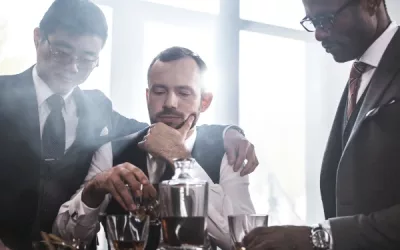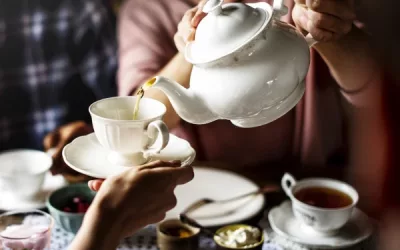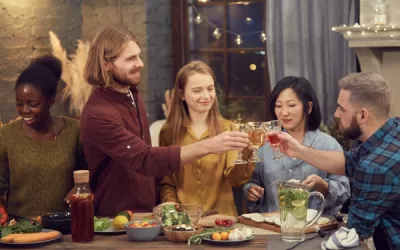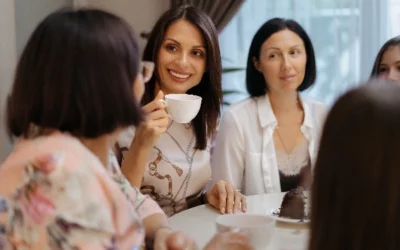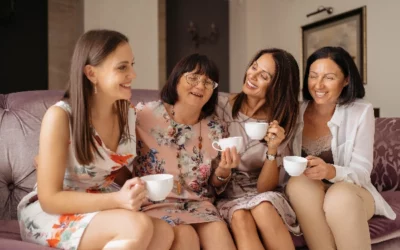Imagine walking into a beautifully decorated room, the scent of freshly baked scones wafting through the air, and the soft clink of delicate china. You can’t help but feel a little nervous about your outfit. What to wear for afternoon tea can be just as important as enjoying the delicious treats served on tiered stands. If you want to make the most of your experience, it’s crucial to know the right attire for the occasion. In this guide, I’ll share all the insider tips you need to ensure you look and feel fabulous, whether you’re celebrating a special moment or simply indulging in a delightful afternoon. Let’s dive in and explore the world of afternoon tea attire together!
Table of Content
- What are the general dress code guidelines for afternoon tea?
- What is considered formal attire for afternoon tea?
- Can semi-formal attire be appropriate for certain venues?
- How do seasonal variations affect what to wear?
- What to wear for afternoon tea?
- What should women wear for afternoon tea?
- What should men wear for afternoon tea?
- How can you incorporate personal style into your afternoon tea outfit?
- Colour choices
- Cultural attire
- Unique accessories
- What are some common mistakes to avoid when dressing for afternoon tea?
- How has the dress code for afternoon tea evolved over time?
- How can you balance style and comfort in your afternoon tea outfit?
- Balancing Style and Comfort: The Basics
- Conclusion
What are the general dress code guidelines for afternoon tea?
Attending afternoon tea is more than just sipping on your favourite brew; it’s an elegant experience often held in traditional settings. As such, your attire should fit the ambiance, whether the event is formal, semi-formal, or casual. Every venue has its own vibe, and what you wear often depends on a blend of factors like the formality of the location, the time of year, and even cultural influences. Let’s delve into the different dress codes you might encounter and how best to navigate them.
Formal attire for afternoon tea zeros in on sophistication. Think elegant dresses, tailored suits, and maybe even a hat if you’re feeling particularly regal. Semi-formal attire offers a bit more flexibility, allowing for dressy trousers and more casual dresses. For casual settings, you could opt for something comfortable but neat, like smart trousers paired with a nice top.
What is considered formal attire for afternoon tea?
In more traditional or luxurious settings, formal attire carries a certain level of sophistication and elegance. This type of venue often requires that guests dress in a way that complements the refined atmosphere. Formal attire for afternoon tea usually means pulling out your best, as if you were attending a special event or celebration.
- Ladies often wear elegant dresses, such as tea-length dresses or modest cocktail dresses.
- Tailored suits, often light-coloured, are a popular choice for men.
- Accessories can include jewellery, a classic handbag, or even a fascinator or hat for added flair.
- Footwear should be polished and stylish but also comfortable enough for the setting.
- Men should consider wearing dress shoes, and possibly a tie or bow-tie.
When you step into a venue with this level of formality, you’ll feel right at home in attire that is both chic and sophisticated. The experience is about blending into an elegant environment seamlessly.
Can semi-formal attire be appropriate for certain venues?
Absolutely, many afternoon tea spots cater to a slightly less formal crowd. Semi-formal attire can be the perfect middle ground, providing a balance between elegance and comfort. This is particularly true for modern or more relaxed venues.
- Women might opt for a stylish skirt and blouse combination or a simple yet elegant dress.
- Men can choose chinos or dress trousers paired with a crisp shirt, perhaps topped with a blazer.
- Minimalist accessories like a nice watch or understated jewellery work well.
- Comfortable, neat shoes such as loafers or ballet flats can be both stylish and practical.
- Earthy tones and simple patterns can offer a relaxed yet polished look.
Choosing semi-formal attire allows you to adapt effortlessly to a venue’s unique atmosphere without appearing overdressed or too casual. It strikes that perfect balance, making you feel comfortable and appropriately dressed.
How do seasonal variations affect what to wear?
What you wear can change quite a bit depending on the season. The time of year often influences both the material and the style of your outfit, ensuring you remain comfortable while still looking chic.
- In spring, opt for light fabrics like cotton or linen. Pastel colours and floral patterns can add a fresh, vibrant touch.
- Summer may call for breathable fabrics and lighter colours. Think sun dresses for women and linen shirts for men.
- In autumn, layering becomes your best friend. Earthy tones and thicker materials such as wool or blends work well.
- Winter attire might include darker, richer colours and warmer fabrics. Consider wearing elegant coats or stylish scarves.
Seasonal variations not only influence clothing material but also colours and patterns. Adapting your wardrobe accordingly ensures you’re both stylish and comfortable, no matter when or where you’re having afternoon tea.
Did you know that Queen Victoria popularised afternoon tea in the 19th century? Anna, the Duchess of Bedford, supposedly initiated this charming tradition. She found herself getting peckish in the long gap between lunch and dinner, so she began inviting friends to join her for tea and light snacks. As a trend-setting figure, Queen Victoria soon embraced this custom, making afternoon tea a staple for the British aristocracy. The tradition has evolved, but the blend of good company, delicious treats, and impeccable style remains the same.
What to wear for afternoon tea?
Selecting the right attire for afternoon tea can be tricky, but understanding the dress code specific to each venue can simplify your task. It’s key to note the type of venue you’re attending because they often have their guidelines or expectations. Dressing appropriately not only shows respect for the venue but also helps you feel comfortable and stylish.
Dressing for afternoon tea isn’t just about looking good, it’s also about feeling confident in your choice. You wouldn’t wear the same outfit to an elegant hotel as you would to a casual cafe. The setting and atmosphere significantly influence what you should wear.
How does the dress code vary by venue?
To provide an easy way to understand how dress codes differ by venue, we have summarised the information in the following table. This table includes various types of venues like traditional and modern hotels, casual cafes, luxury restaurants, and unique outdoor settings such as gardens. Each row provides a description of the dress code, examples of specific venues, suggestions on appropriate attire, and any additional notes to keep in mind.
| Venue Type | Dress Code Description | Example Venues | Appropriate Attire | Notes |
|---|---|---|---|---|
| Traditional Hotels | Classic, elegant, often semi-formal | The Ritz London, Savoy Hotel | Dresses, skirts with blouses, suits | Avoid overly casual items like jeans |
| Modern Hotels | Smart casual to business casual | The Shard, The Biltmore Mayfair | Tailored trousers, smart blouses, blazers | Allow for more creative fashion choices |
| Casual Cafes | Casual to smart casual | Bea’s of Bloomsbury, Peggy Porschen | Chic dresses, jeans with stylish tops, smart jumpers | Comfort with a touch of style |
| Luxury Restaurants | Formal to semi-formal, elegant | Sketch London, Claridge’s | Cocktail dresses, tailored suits, polished accessories | Opt for statement pieces |
| Garden Settings | Semi-formal to smart casual | Kensington Palace Pavilion, Petersham Nurseries | Floral dresses, hats, lightweight blazers | Consider weather and walking paths |
| Boutique Teahouses | Eclectic, vintage-inspired | Betty’s Tea Rooms, Tea & Tattle | Vintage dresses, quirky accessories, tailored jackets | Play with unique, standout pieces |
Using and understanding the table:
- Venue Type: Describes the general category of the location.
- Dress Code Description: Summarises the expected style of dress.
- Example Venues: Provides specific well-known locations.
- Appropriate Attire: Offers suggestions for what you might wear to fit in.
- Notes: Additional points to consider before choosing your outfit.
Let’s break down a bit more on what different settings might require.
Traditional hotels
Traditional hotels often have a refined and sophisticated atmosphere. The dress code leans towards semi-formal, with a classic and elegant twist.
- Appropriate attire typically includes:
- Dresses or skirts with blouses
- Tailored suits
- Smart shoes
When you’re at venues like The Ritz London or The Savoy Hotel, it’s best to avoid overly casual items, like ripped jeans or sneakers. A polished look complements the luxurious surroundings and enhances your experience.
Modern hotels
Modern hotels balance between smart casual and business casual, offering a more contemporary style.
- Appropriate attire includes:
- Tailored trousers and blouses
- Stylish blazers
- Neat, polished accessories
Examples such as The Shard or The Biltmore Mayfair give you room to experiment with creative fashion choices, mixing elegance with modernity.
Afternoon tea became a fashionable social event in England in the early 1840s. Anna, the Duchess of Bedford, is credited with introducing the tradition. She complained of having “that sinking feeling” during the late afternoon, so she started having a pot of tea and a light snack in her boudoir. She began inviting friends to join her, and it turned into a grand social affair. The dress code was initially informal, but as it grew in popularity, so did the importance of attire, eventually morphing into the cherished tradition we see today.
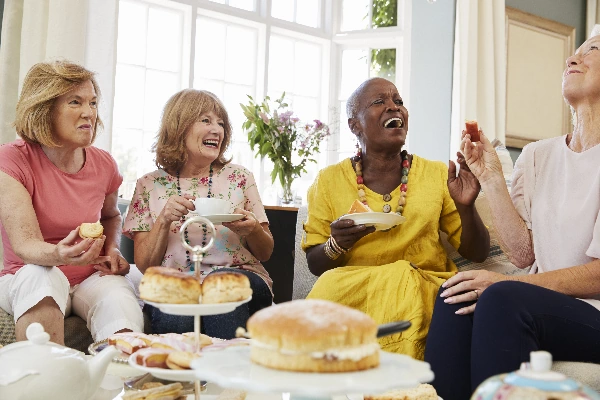
What should women wear for afternoon tea?
When it comes to afternoon tea, you’re stepping into a world of delicate sandwiches, scones, and, of course, some posh attire. It’s not just about the finger sandwiches and clotted cream; it’s about looking fabulous while indulging in these treats. Think of it as a fashion show with a side of Earl Grey.
Traditionally, women dress up a tad more refined for afternoon tea, but don’t feel like you need to pull out your grandmother’s vintage lace. It’s about striking a balance between style and comfort. Whether you’re attending a ritzy affair in a five-star hotel or a cosy setting in a quaint café, the goal is to look polished and feel comfortable.
Are dresses always the best choice for women?
Ah, dresses – the one-piece wonder that saves you the hassle of matching separates. But are they always the best choice for women at afternoon tea?
- Dresses are a go-to option for many because they can be effortlessly chic.
- A knee-length dress with a classic silhouette – think A-line or wrap – is a safe bet.
- Avoid anything too clingy or low-cut; we’re not aiming for the nightclub look.
- Maxis can be lovely but ensure they’re not dragging – tea and tripping aren’t a match made in heaven.
- Opt for light, breathable fabrics like cotton or silk; avoid anything that makes you sweat buckets under the afternoon sun.
But, let’s not forget about alternatives. A smart skirt paired with a pretty blouse can be just as lovely. It gives you the flexibility to mix and match and play with patterns and textures.
What types of accessories complement an afternoon tea outfit?
Accessories can make or break your look. They can take you from drab to fab, but remember, we’re going for posh, not peacock.
- A delicate, elegant hat fits splendidly with the afternoon tea vibe – just make sure it doesn’t end up in your soup.
- Statement jewellery can add sparkle but keep it tasteful. Think pearls or dainty chains, not your oversized festival bling.
- A sophisticated clutch or a small handbag keeps your essentials close and adds a touch of class.
- A silk scarf draped casually around your neck or shoulders can elevate a simple dress or blouse.
- Sunglasses, if you’re outdoors, but opt for classic shapes over futuristic designs. Channel Audrey Hepburn, not The Terminator.
The devil is in the details. Don’t overdo it. Choose one or two key pieces to enhance, not overshadow your outfit.
How should women choose their shoes for comfort and style?
Heels? Flats? Ballet pumps? The shoe dilemmas are endless when aiming for the perfect blend of comfort and style.
- Low to mid heels offer the right balance between looking smart and avoiding that tottering-on-stilts effect.
- Ballet pumps or dressy flats are lifesavers if you expect a lot of standing or walking.
- Ankle boots can also work, particularly in cooler weather, but keep them sleek and elegant.
- Sandals – but opt for those with a refined look. Leather gladiator sandals? Maybe skip them for this occasion.
- Colours should complement your outfit. Neutrals like black, nude or pastel shades often hit the mark.
Remember, comfortable feet mean you can enjoy your tea without the distraction of blisters. You want to be noticed for your grace, not your wince every time you step.
In the late 19th century, afternoon tea started to become fashionable under the influence of Anna, the 7th Duchess of Bedford. She found the long hours between lunch and dinner unbearable and began inviting friends to join her in her rooms at Woburn Abbey. They’d enjoy a selection of small sandwiches, pastries, and, of course, tea. Word spread, and soon, it became the social event of the day. The ladies attending these fashionable gatherings would don their finest attire, making the ritual not only about tea and treats but also about appearing in the latest fashions. So when you’re pouring over your wardrobe choices, know you’re partaking in a time-honoured tradition, where looking your best is as essential as the tea itself.
What should men wear for afternoon tea?
Let’s be honest: deciding what to wear for afternoon tea can be as baffling as reading ancient hieroglyphs. You might think it’s just tea, but in reality, you’re walking into a sophisticated tradition where style matters. So, what should men wear to not look like they just rolled out of bed? You’ve got suits, blazers, trousers, accessories, and shoes to think about. Oh joy. Here’s your guide:
Suit up! Or maybe not. Maybe just stick to a smart blazer. Honestly, the world of afternoon tea attire can be as confusing as quantum physics. While the rules can be tricky, mastering them isn’t impossible. So, let’s decode this puzzle and ensure you’re the best-dressed chap sipping Earl Grey.
Is a suit always necessary for men?
Sure, a suit can scream sophistication, but is it always mandatory for afternoon tea?
- Setting matters: If you’re heading to The Ritz or some other swanky joint, a suit is a solid choice. They’ll appreciate your effort.
- Flexibility: Casual afternoon tea at a cosy local café doesn’t demand a suit. Opt for a sharp blazer instead.
- Weather considerations: Baking under the sun? Skip the three-piece ensemble and choose a light blazer. You don’t want to be the guy sweating rivers.
- Fit and fabric: A well-tailored suit can make you look like a million bucks. Choose comfortable fabrics like linen or cotton for breathability.
- Versatility of blazers: Think of a blazer as a suit’s cool younger brother. It offers polish without the stiffness.
When it comes to suits and blazers, context is king. No need to sweat in full armour if a blazer does the trick.
What types of accessories should men consider?
Ah, accessories—the fine line between looking dapper and resembling a Christmas tree. Opt for:
- Watches: A classic timepiece can add an element of refinement. Skip the sports watch.
- Pocket squares: These little squares can jazz up your attire without much effort. Plus, they come in handy if you spill your tea.
- Ties and bow ties: Depending on the venue, a tie can make you look finished and formal. Bow ties can be quirky and charming.
- Cufflinks: These are the bling of the classy world. If your shirt has French cuffs, cufflinks can add a touch of elegance.
- Brogues or loafers: Footwear this chic is almost an accessory in itself. Aim for understated sophistication.
Accessories should complement, not overshadow, your overall ensemble.
How can men balance comfort and style in their footwear?
Shoes are the unsung heroes of any outfit. They carry you around, literally. When it comes to balancing comfort and style for afternoon tea, here’s the scoop:
- Oxfords or Brogues: Both classic choices that ooze style. Make sure they’re well-polished.
- Loafers: These slipper-like shoes offer sophistication with comfort. Perfect for both indoor and garden tea parties.
- Sneakers: Only acceptable if they’re ultra-stylish and clean. Keep the athletic trainers at home.
- Shoe fabric: Leather shoes are a timeless choice. For warmer months, consider suede or fabric loafers.
- Insoles: If you love a particular pair but dread the idea of wearing them for hours, consider cushioned insoles.
Shoes should make you feel confident and comfortable. No one likes hobbling around because their style game is too strong.
Back in the 1860s, afternoon tea became a fashionable social event thanks to Anna, the Duchess of Bedford. Tired of the long gap between lunch and dinner, she started inviting friends over for tea and snacks. Before long, it wasn’t just about sipping a cuppa; it was the place to see and be seen. Hence, the standards for afternoon tea attire took off. Even today, maintaining that timeless blend of comfort and style continues to be key, proving that some things never change.
How can you incorporate personal style into your afternoon tea outfit?
Let’s talk about how to bring your personality into that traditional afternoon tea outfit. Spoiler alert, it’s not all about pearls and pastel dresses. Would you like to add some spice to the tradition? Now, we’re talking!
Colour choices
Here’s the thing about colours. They basically scream your personality without you having to utter a single word. Love vibrant and bold hues? Go for reds, blues, or any shade that tickles your fancy. Are you the understated elegance type? Stick to creams, blushes, and maybe a dash of navy. Here’s how to nail it:
- Match with your skin tone: Trust me, finding colours that complement your skin tone makes a world of difference.
- Seasonal palettes: Imagine waltzing into an autumn-themed tea party in rich russet or a spring fling in floral prints.
- Colour psychology: Reds for confidence, blues for tranquility, and yellows for joy. Your clothes can do the talking.
- Mix and match: Don’t be shy to combine colours. Just do it sensibly. Had a run-in with a rainbow? Maybe tone it down.
- Personal favourites: Ultimately, pick colours that make you feel great. You’ll look fabulous if you feel fabulous.
Speaking of colours, historical figures like Queen Elizabeth I were known for her bold sartorial choices that reflected her powerful and unapologetic character. If it’s good enough for a queen, it’s good enough for us mere mortals.
Cultural attire
Cultural dress can add a unique touch to your tea-time ensemble. And yes, it’s more than appropriate. Think of it as adding a slice of your world to this elegant ritual:
- Kimono: An elegant Japanese kimono can be a showstopper. Simple, yet sophisticated.
- Sari: Draping a beautifully coloured sari from India can add grace and charm.
- Cheongsam: This is a traditional Chinese dress that is both stunning and comfortable.
- Kilt: If you’re of Scottish heritage, flaunt that tartan kilt proudly.
- Boubou: An intricately designed African boubou can be both regal and contemporary.
Not only does cultural attire represent where you come from, but it also adds an extra layer of storytelling to your outfit. When Lady Diana attended a state banquet in Japan, she donned a variation of traditional Japanese attire, blending British royalty with Japanese culture. Talk about a win-win.
Unique accessories
Accessories are like the cherry on top of your sundae. They can elevate a basic outfit to haute couture level. So, what’s on the menu?
- Hats: From dainty fascinators to wide-brimmed sun hats, channel your inner Audrey Hepburn.
- Scarves: Silk, chiffon, or pashmina. Scarves add a dash of elegance.
- Jewellery: Statement pieces or delicate chains, your choice. Just don’t overdo it; we’re not going for mobile jewellery shops.
- Bags: Tiny clutch, elegant handbag, or a quirky vintage piece. Practical yet stylish.
- Shoes: Heels, flats, or chic boots. Make sure they’re comfortable, or you’ll be hobbling out before tea’s done brewing.
Remember, accessorising is an art. It’s about highlighting your personal style while staying appropriate for the occasion.
The art of accessorising can be traced back centuries. Coco Chanel, the queen of minimalistic elegance, famously said, “Before you leave the house, look in the mirror and take one thing off.” Even in the roaring ’20s, she knew the power of a well-chosen accessory.
So there you have it. Incorporating personal style into your afternoon tea outfit is not just possible, it’s practically a requirement. Enjoy the tea, and rock that outfit!
What are some common mistakes to avoid when dressing for afternoon tea?
When it comes to afternoon tea, knowing what to wear is crucial. You’ve got to nail that classy yet casual vibe, like you’re after a sophisticated stroll in the park rather than a court appearance. However, there are a few common pitfalls that can turn your delightful day into a fashion nightmare.
Now, let’s delve into these faux pas one by one, covering overdressing, underdressing, ignoring venue guidelines, neglecting comfort, and inappropriate accessories. Consider this your crash course in tea-time chic.
What are the risks of overdressing?
Let’s start with the most glaring blunder: overdressing. Looking like you’re headed to a royal wedding when others are in Sunday casual can put you in an awkward spotlight. Overdressing risks making you feel out of place and can be a buzzkill for your own enjoyment.
- Too much glamour: Wearing an evening gown or tuxedo can make you appear like you’re trying too hard.
- Excessive makeup: Going full glam face for an afternoon event is like using a sledgehammer to drive a nail.
- Heavy jewellery: Dripping in diamonds might overshadow the delicate treat – and you don’t want to be the distraction.
- Highly formal footwear: Think stilettos for park sashay. It’s impractical and unnecessary.
- Elaborate hairdos: You’re at tea, not at the Met Gala. Keep it understated.
Overdressing screams “Look at me!” in an environment where subtle sophistication is key. It’s not just about others; you’ll likely feel uncomfortable being overdressed, which can affect your enjoyment.
How can underdressing affect your experience?
Equally detrimental is turning up like you’ve just rolled out of bed or you’re en route to the gym. Underdressing can affect your experience by bringing unwanted attention and making you feel underprepared.
- Lack of respect: Looking scruffy can be seen as a disrespect to the venue and the tradition of afternoon tea.
- Comfort issues: Overly casual attire can be uncomfortable if it’s a posh venue.
- Wrong footwear: Flip-flops or trainers might not be suitable for the setting.
- Old or worn out clothes: Save the frayed jumpers and faded jeans for another day.
- Too casual accessories: Baseball caps and big backpacks can give the wrong impression.
Being underdressed can lead to self-consciousness and may detract from enjoying the experience. To keep things elegant yet relaxed, aim for a smart-casual outfit.
Why is it important to follow venue guidelines?
It’s important to follow venue guidelines because they set the tone and ensure everyone is on the same page. Ignoring these can lead to embarrassing situations, like being turned away or feeling out of place.
- Dress code enforcement: Some venues have strict dress codes and won’t hesitate to show you the door.
- Cultural sensitivity: In certain places, traditional attire might be expected.
- Event-specific guidelines: Whether it’s a themed tea or a luxury hotel, rules can vary.
- Ensuring comfort: Guidelines often suggest practical attire for the venue’s environment.
- Respect traditions: Afternoon tea is a tradition; following guidelines shows you respect it.
Following the venue’s dress code ensures you fit in, feel comfortable, and show respect for the tradition of afternoon tea. It’s like showing up to a pool party with a swimsuit – nobody needs to tell you twice.
So let’s tie this all together. The key to nailing afternoon tea attire is to strike a balance: polished but not over-the-top, appropriate without being too casual, and aligned with the venue’s expectations. Now, let’s look at a fascinating tidbit from history that illustrates what happens when you don’t quite get it right.
In the 19th century, Queen Victoria’s Afternoon Tea parties were the height of fashion and etiquette. One year, a newcomer to the royal court showed up in a flamboyant ball gown rather than the recommended light day dress. The Queen, always a stickler for decorum, was less than impressed. Thankfully, she was gracious enough to not show her dissatisfaction openly, but the poor woman felt like a peacock among swans and probably spent the entire event wishing she’d opted for a simpler outfit. This little historical lesson goes to show: it’s best to blend in gracefully.
How has the dress code for afternoon tea evolved over time?
Let’s take a trip down memory lane and have a blast while discussing the evolution of afternoon tea attire. It’s not as snooze-worthy as you think! We’ll dive into the past, explore societal shifts, ogle some fashion trends, and even gaze into the future. Grab your imaginary cup and let’s get started.
First things first: the historical origins of the afternoon tea dress code. Picture this: Victorian-era England, where upper-class ladies and gents donned their finest threads to hobnob over tea and scones. Yes, they probably judged you if your lace was subpar. Back then, afternoon tea was an event, darling!
Fast forward a century or two, and societal norms have shaped the dress code significantly. You don’t need to wear a ball gown to sip Earl Grey, but please, no flip-flops. Dress codes have relaxed but retained a touch of formality.
Then we have modern venues that throw a stylish curveball into the mix. Swanky hotels, trendy cafes, and even outdoor settings now host afternoon teas. This diversity in venues means you can get away with anything from a smart-casual look to a more laid-back but chic ensemble.
So, what does the future hold? Fashion influencers are probably already plotting the next big thing. Think sustainability and comfort without sacrificing elegance. Expect to see a blend of tradition with a dash of modernity – and a lot more Instagrammable outfits.
What were the historical origins of the afternoon tea dress code?
Back to the original tea party from the 1800s. People didn’t just wake up and decide to wear corsets and crinolines. Blame Anna, the Duchess of Bedford. She birthed this ritual to bridge the gap between lunch and dinner. Can you imagine spending hours in tight clothing just for tiny sandwiches and cakes? But hey, that’s dedication.
- Victorian era clothing: Think layers, tonnes of them.
- Women: Floor-length dresses, tight corsets, and elaborate hats.
- Men: Waistcoats, top hats, and suits.
- Accessories: Gloves, jewellery, and lace – loads of lace.
- Fabrics: Luxurious materials like silk, satin, and velvet.
These ensembles weren’t just fashion statements, they screamed, “I have more money than you.” The focus on opulence set the tone for afternoon tea as a prestigious event.
How have societal norms influenced changes in the dress code?
Fast forward to the 20th century, when comfort began to matter. Nobody wanted to faint over a cucumber sandwich. The roaring ’20s and beyond saw hemlines rise and corsets burn. Civil rights and gender equality movements played key roles.
- 1920s: Flapper dresses and bob haircuts replaced restrictive outfits.
- 1950s: The classic tea dress with a fitted bodice and flared skirt reigned supreme.
- 1970s: Freedom! Think boho-chic and flowing fabrics.
- 1990s: Smart-casual becomes a thing, hello blazers and jeans.
Society’s evolution towards inclusivity and personal expression meant that afternoon tea attire became less rigid. You can be classy without being uncomfortable.
What impact have modern venues had on the dress code?
Now that we’ve gotten out of history class, let’s talk about the present. Modern venues cater to a diverse crowd. Whether you’re at a fancy hotel or a quirky café, the dress code reflects the atmosphere.
- High-end hotels: Still lean towards smart attire.
- Trendy cafes: Expect more relaxed but stylish outfits.
- Outdoor settings: Bring in a touch of practicality with style.
- Theme-based tea venues: Get creative based on the theme (Downton Abbey, anyone?).
Each venue has its own vibe. Not everyone’s going to a posh hotel; you might be at a rustic garden tea. So, dress to impress, but also to fit the setting.
In 1865, the Langham Hotel in London kicked off the ‘afternoon tea craze’ among the upper classes. This trend later trickled down, eventually becoming a beloved British pastime. So, the next time you sip on your Darjeeling, know you’re partaking in a rich tradition that said, “Let’s dress up and gossip over cake!”
How can you balance style and comfort in your afternoon tea outfit?
Alright, so you managed to snag an invite to an afternoon tea session. Congratulations! Step one: don’t panic. Step two: avoid showing up in sweatpants (no matter how comfy they are). Balancing style and comfort is key, and it’s easier than you might think. Let’s break it down, so you show up looking chic, yet feeling like you’re wrapped in clouds.
Balancing Style and Comfort: The Basics
First thing’s first—think strategically about fabric choices, layering options, footwear, fit, and the all-important weather. Yes, all these elements contribute to a killer outfit that doesn’t make you want to rip it off by the end of the afternoon.
What fabric choices are best for comfort and style?
When it comes to choosing the right fabric, you want something breathable yet elegant, durable yet soft. Here’s a quick rundown of your best allies in the fabric department:
- Cotton: The classic choice. Light, breathable, and versatile.
- Linen: Perfect for warm climates; it screams sophistication while keeping you cool.
- Silk: Luxurious and soft, but be mindful of sweating—it can turn into a damp mess.
- Wool blends: Ideal for cooler weather, offering both warmth and style.
- Cashmere: For the ultimate luxe comfort, but make sure it’s not too hot for the occasion.
Cotton and linen are your go-to comrades in warmer settings, while wool blends and cashmere save the day when it’s chilly. Remember to steer clear of synthetic fabrics—they might look good but can be as breathable as a plastic bag.
How can layering help balance style and comfort?
Layering isn’t just a winter sport. It’s the secret to being fashionably flexible in variable conditions. Here’s how it can work:
- Cardigans: A lightweight cardigan can be tossed over a sleeveless or short-sleeve blouse for added warmth.
- Scarves: Not just a neck warmer—an elegant scarf can add flair to your outfit.
- Blazers: A well-fitted blazer can take an outfit from casual to classy in seconds.
- Light shawls: Perfect for pairing with summer frocks; they add an extra layer without the bulk.
- Undershirts: Seamless undershirts can provide you with an extra layer without any visible lines.
Layering lets you adjust on the fly. Feel a chill? Pop on that cute cardigan. Sweating bullets? Chuck it off and you’re still fabulous. The flexibility to adapt while maintaining your style is what it’s all about.
Why is the appropriate fit crucial for comfort?
Fit can make or break your afternoon tea experience. Squeezing into something too tight will have you fidgeting more than a pigeon on a hot roof. Here’s why the right fit matters:
- Ease of movement: Make sure you can sit, move, and eat without feeling restricted.
- Flattering yet comfortable: A well-fitted outfit accentuates your shape without cutting off your circulation.
- Breathability: Clothes that are too snug won’t allow your skin to breathe, turning a potentially wonderful afternoon into a sweaty disaster.
- Layer suitability: If your base layer is too tight, adding layers will only exacerbate the discomfort.
- Self-confidence: An outfit that fits well makes you feel good about yourself, allowing you to enjoy the company and the cakes.
A properly fitting outfit doesn’t just look good, it feels good too. Not too tight, not too loose—the Goldilocks zone of clothing ensures you look polished and feel comfortable.
In the roaring 1920s, Coco Chanel revolutionised women’s fashion with her relaxed and comfortable designs. She introduced jersey fabric, previously used only for men’s underwear, to create chic and comfortable dresses for women. Chanel understood that style didn’t have to be sacrificed for comfort. Her innovative approach gave women the freedom to breathe in their clothes, quite literally, and reshaped fashion forever. Now, taking a leaf out of Chanel’s book—go forth and conquer that afternoon tea, looking ever so stylish and feeling absolutely fabulous.
Conclusion
As I reflect on the key points explored throughout this article, it’s clear that dressing for afternoon tea is both an art and a science. Striking the right balance between formal, semi-formal, and even casual attire hinges on understanding the venue and occasion.
Each recommendation serves to enhance your experience, from the elegance of dresses and tailored suits to the carefully chosen accessories that reflect personal style. I’ve aimed to shed light on how the evolving social norms and fashion trends shape our choices today, making it essential for us to consider both comfort and style.
The etiquette of afternoon tea does not simply lie in adhering to dress codes; it encompasses a deep appreciation for the tradition and social interactions that this cherished ritual offers. Whether you find yourself in a lavish hotel or a relaxed café, being aware of the nuances of your environment can elevate your experience. As you prepare for your next afternoon tea, take a moment to contemplate what your attire says about you and your respect for this timeless event.
I encourage you to express your personal style when deciding what to wear, keeping in mind the guidelines provided. Perhaps you might even want to experiment with cultural attire or unique accessories that tell a story about who you are. Remember, making thoughtful choices reflects the grace of this occasion.
In closing, I leave you with a question: How will you curate your outfit to not only reflect your style but also honour the delightful tradition of afternoon tea? After all, as the saying goes, “Style is a way to say who you are without having to speak.” As you sip your tea and savour exquisite pastries, may your attire be a beautiful companion to the joy of the experience.


